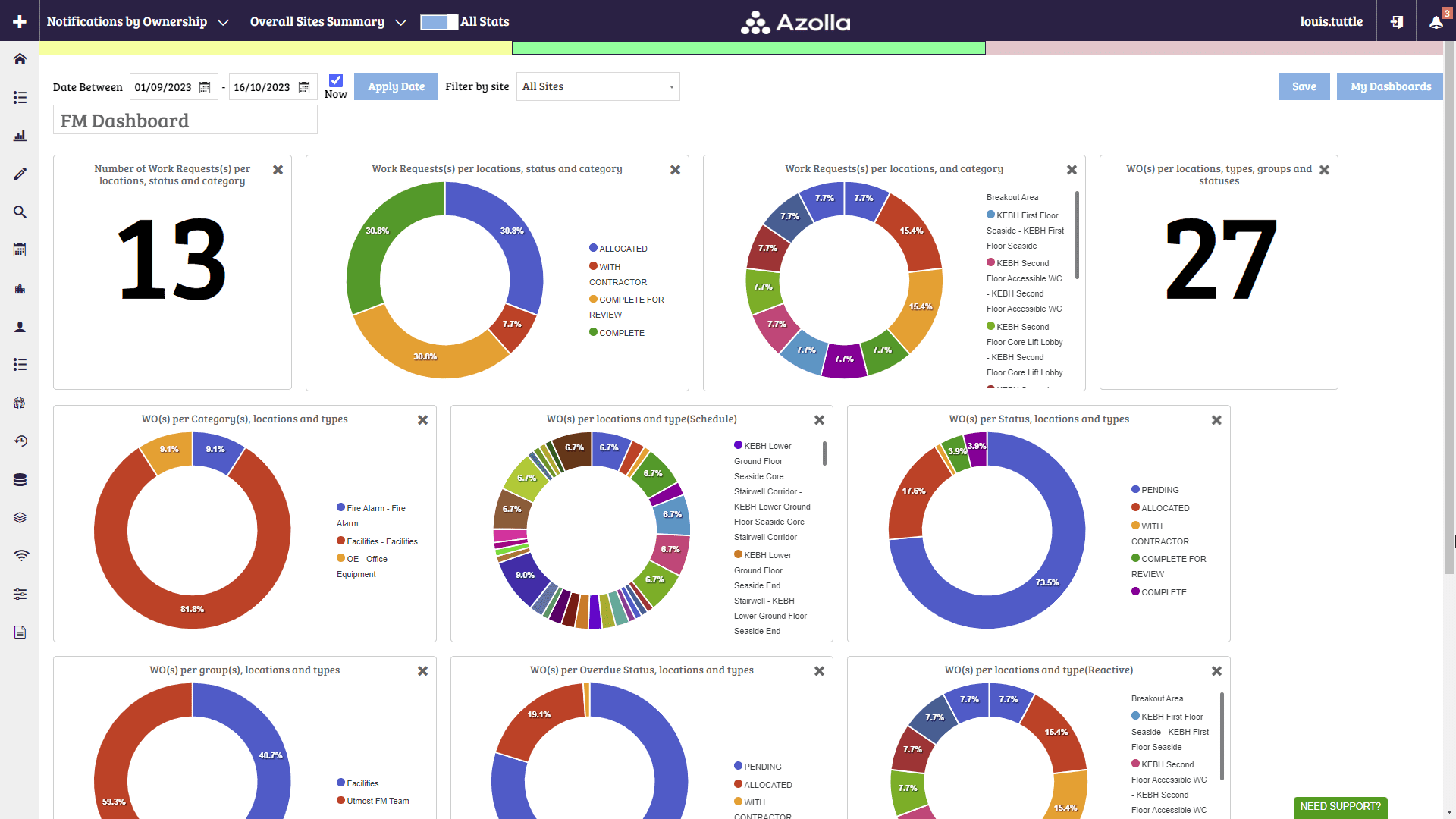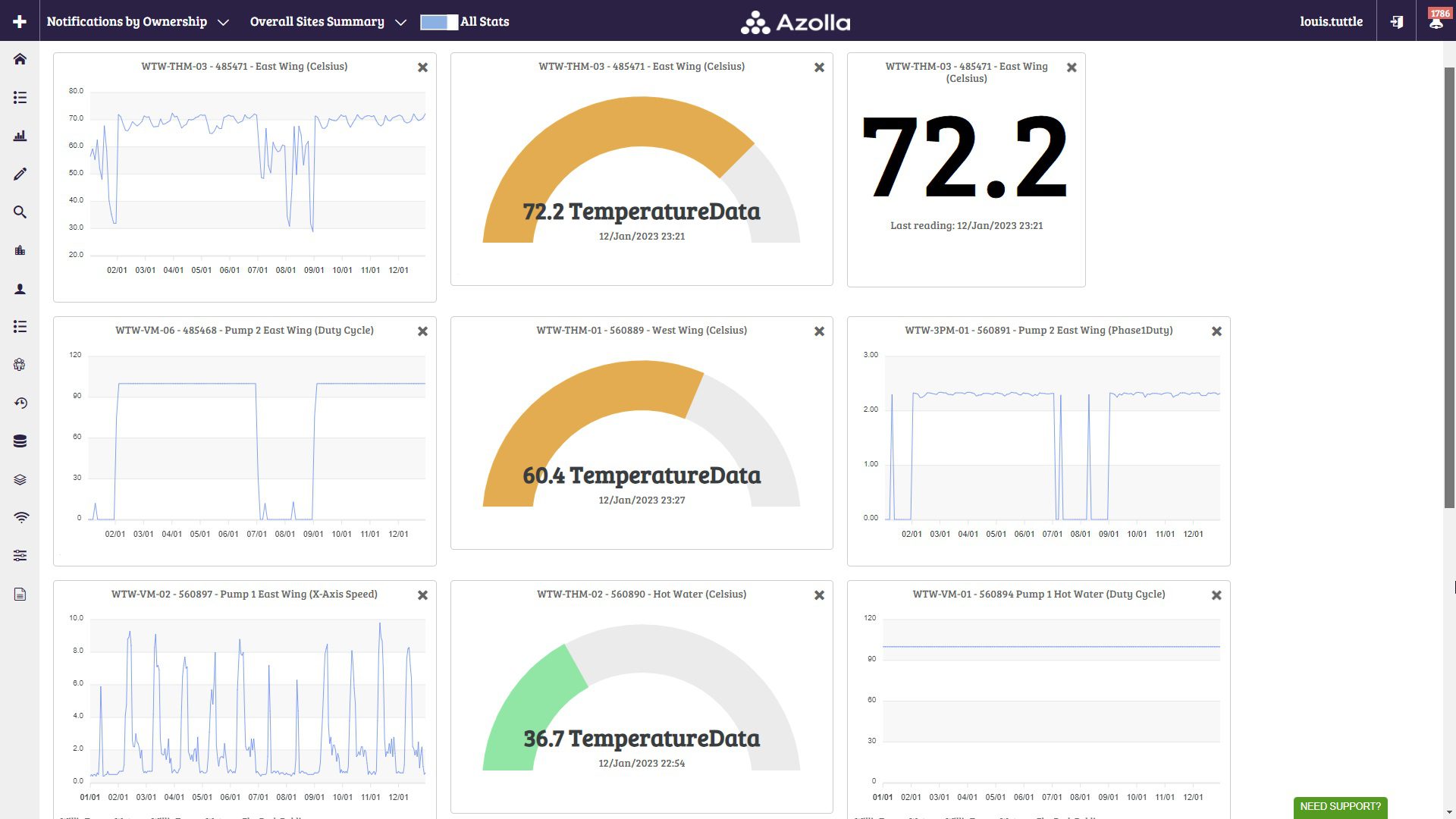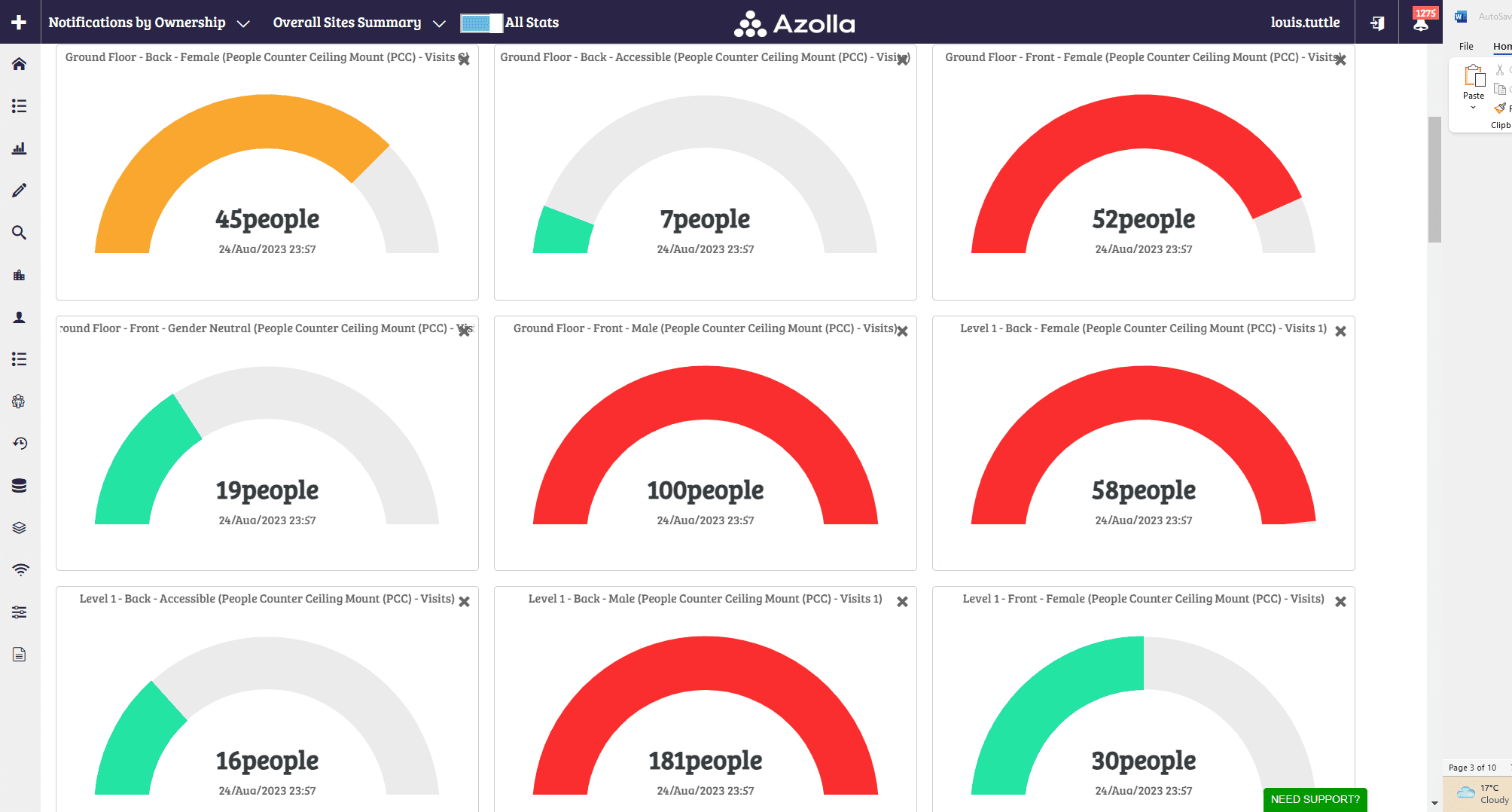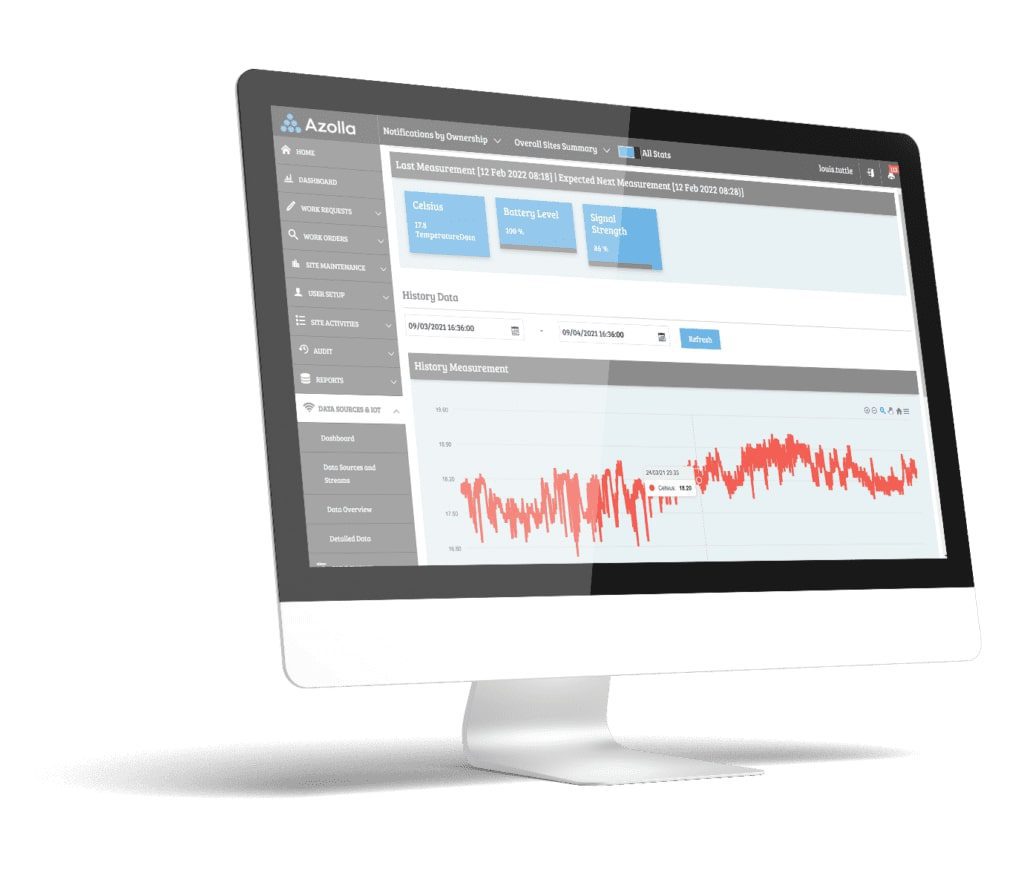Making IOT Work for the Customer
Asset Maintenance Management
As Facilities Managers, Asset Maintenance Managers, Field Service Engineers or Technicans, your primary role is to oversee the efficient management of an organisation’s physical assets. This responsibility encompasses both planned and reactive maintenance services.
Your tasks include resource allocation, strategic planning, meticulous scheduling, initiating site access requests, and conducting essential site inductions for personnel. These preparatory activities are essential to ensure that maintenance or service work proceeds smoothly and safely.
Additionally, it’s crucial to maintain accurate documentation of completed tasks, track associated costs, and promptly generate invoices and detailed service reports for client approval. This promotes transparency and accountability throughout the maintenance process.
With Azolla, you can effectively manage your asset portfolio across multiple locations in one system. Moreover, you have the potential to proactively address maintenance issues before they escalate by leveraging sensor technology and the Azolla IoT system, ensuring uninterrupted operations and asset reliability.
What we do for ASSET Maintenace, field service engineers and techs in fm
We make implementing a Service Maintenance Model easy, lower the administration costs and reduce the unproductive time filling in paperwork.
Asset Management
-
Enhanced Asset Visibility: Facilities Management solutions provide real-time asset tracking and monitoring, improving visibility into the condition and location of assets, leading to better asset utilisation.
- Optimised Asset Lifespan: Asset management features enable proactive maintenance and repairs, extending the lifespan of assets, reducing replacement costs, and ensuring optimal performance.
- Reduced Downtime: Through effective asset management, downtime due to unexpected failures is minimised, ensuring operational continuity and improved customer satisfaction.
-
Data-Driven Decision-Making: Asset management tools offer valuable data and analytics, enabling data-driven decisions on asset replacement, maintenance strategies, and budget allocation.
Predictive Maintenance
-
Minimised Downtime: Predictive maintenance uses data analytics and sensors to predict asset failures, allowing for proactive interventions, reducing unplanned downtime.
- Cost Savings: By identifying potential issues before they become critical, predictive maintenance can lower repair and replacement costs while maximising asset lifespan.
- Improved Safety: Reducing unexpected equipment failures enhances workplace safety by preventing accidents that may result from faulty machinery.
-
Optimised Maintenance Resources: Predictive maintenance allows field service engineers to focus their efforts on the assets that need attention, leading to resource optimisation and improved efficiency.
Preventive Maintenance
-
Risk Mitigation: Preventive maintenance ensures that assets are regularly inspected and serviced, reducing the risk of catastrophic failures that can lead to costly downtime or safety hazards.
- Extended Asset Life: Routine inspections and maintenance help assets operate at peak efficiency, leading to longer lifespans and reduced replacement costs.
- Regulatory Compliance: Preventive maintenance helps organisations comply with industry regulations and standards, reducing the risk of fines and legal issues.
-
Improved Asset Performance: Regular upkeep ensures assets consistently perform at their best, contributing to higher productivity and customer satisfaction.
Planning / Scheduling (Multi-site)
-
Efficient Resource Allocation: Multi-site planning and scheduling tools help allocate field service engineers and resources optimally, minimising travel time and costs.
- Maximised Workforce Productivity: Effective scheduling ensures that field service engineers are engaged in productive work, reducing idle time and increasing service delivery.
- Enhanced Customer Service: Timely scheduling ensures that customers receive services when they need them, leading to improved satisfaction and loyalty.
-
Cost Control: Efficient planning and scheduling can help control labour and transportation costs, making operations more cost-effective and profitable.
Work Order Management
-
Streamlined Operations: Work order management allows for the efficient creation, assignment, and tracking of tasks, improving workflow coordination and reducing operational bottlenecks.
- Enhanced Communication: Field service engineers can receive and provide real-time updates on work orders, leading to improved communication and faster issue resolution.
- Work History Documentation: Work order systems maintain a record of all tasks performed, aiding in historical reference, compliance, and audit trails.
-
Resource Allocation: Work order management tools help optimise the allocation of resources, ensuring the right skills and equipment are available for each task.
Planned and Statutory Maintenance
-
Accurate Time Tracking: Timesheets enable precise tracking of working hours, facilitating payroll management and helping organisations stay compliant with labour laws.
- Project Cost Control: Monitoring time spent on different tasks or projects allows for better cost control and helps in budgeting and resource allocation.
- Billing Accuracy: Timesheets are crucial for service billing accuracy, ensuring that customers are charged correctly for the work performed.
-
Productivity Insights: By analysing timesheet data, organisations can identify productivity trends and areas for improvement in their field service operations.
Cost Management
-
Budget Adherence: Effective cost management tools assist in staying within budget limits for asset maintenance and field service operations.
- Cost Reduction: By identifying inefficiencies and areas of overspending, cost management solutions help reduce operational costs.
- Data-Driven Decision-Making: Data analytics within cost management tools provide insights to make informed decisions about resource allocation and cost-saving measures.
-
Financial Reporting: Cost management systems generate detailed financial reports, aiding in budget planning and forecasting.
Health & Safety
-
Risk Mitigation: Health and safety features ensure that field service engineers adhere to safety protocols, reducing the risk of accidents and associated liabilities.
- Regulatory Compliance: Compliance with health and safety regulations is crucial; these solutions help organisations meet legal requirements and avoid penalties.
- Incident Reporting: Systems for health and safety provide tools for incident reporting and documentation, assisting in investigations and improving safety measures.
-
Employee Well-being: By prioritising health and safety, organisations demonstrate their commitment to the well-being of field service employees, boosting morale and retention.
Permit to Work
- Safety Control: Permit to work systems establish a controlled process for high-risk tasks, ensuring that they are performed safely and with the necessary precautions.
- Documentation and Accountability: These systems maintain a record of permits, providing documentation and accountability for critical tasks.
- Risk Assessment: Permit to work processes include risk assessments, helping to identify and mitigate potential hazards before commencing work.
- Regulatory Compliance: These systems assist organisations in adhering to regulations regarding hazardous work, reducing the risk of legal issues and penalties.
Supplier and Contractor Portal
-
Efficient Procurement: Supplier and contractor portals streamline the procurement process, enabling organisations to efficiently source goods and services.
- Collaboration: These portals facilitate communication between organisations and their suppliers or contractors, enhancing collaboration and information sharing.
- Transparency: Portal solutions provide transparency into supplier performance and contractual obligations, helping in the selection of reliable partners.
-
Cost Control: Efficient procurement and contractor management can lead to cost savings and improved cost control.
IoT (Internet of Things)
-
Real-Time Monitoring: IoT devices enable real-time monitoring of assets, allowing for immediate identification of issues and proactive maintenance.
- Data-Driven Predictions: IoT data can be analysed to predict asset performance, improving maintenance planning and resource allocation.
- Energy Efficiency: IoT devices help optimise energy consumption, reducing operational costs and environmental impact.
-
Remote Diagnostics: IoT enables remote diagnostics, reducing the need for physical site visits and improving response times for repairs.
Equipment History
- Maintenance Records: Equipment history provides a comprehensive record of maintenance and repair activities, aiding in compliance and troubleshooting.
- Performance Analysis: Historical data on equipment performance helps in identifying trends and making informed decisions on replacement or upgrades.
- Warranty Management: Equipment history assists in tracking warranty information, ensuring timely claims and reducing repair costs.
- Asset Lifecycle Management: Knowledge of equipment history is crucial for effective asset lifecycle management, ensuring assets are optimally maintained and utilised.
“An advanced asset maintenance system empowering field engieering to shift from costly downtime to streamlined operations, fostering a culture of efficiency, cost savings, and optimised asset performance.”
ASSET MAINTENANCE SECTOR FM USE CASES

Remote Asset Monitoring
Field service engineers employ IoT technology to remotely track and monitor asset performance, allowing for proactive maintenance and minimising downtime, ultimately enhancing operational efficiency.

Equipment Monitoring with IoT
IoT sensors collect real-time data on equipment conditions, aiding maintenance management by enabling timely maintenance tasks, reducing breakdowns, and extending asset lifespan through data-driven insights.

Usage based Maintenance
IoT sensors capture run time hours to trigger maintenance actions based on actual asset usage, optimising maintenance scheduling and cost-efficiency by addressing wear-and-tear precisely.

SCADA Integration
Field service engineers integrate SCADA systems to gain comprehensive control and visibility over assets, streamlining maintenance processes and enhancing asset reliability through real-time data integration.

Vibration Analysis Monitoring Equipment
Predictive maintenance engineers use vibration analysis to monitor equipment health, enabling early detection of issues and preventing costly breakdowns by identifying irregular vibrations.

Permit to Work
Asset maintenance management involves strict adherence to permit-to-work procedures, ensuring the safety of field service engineers and assets during maintenance activities, while also complying with regulatory standards.
Return on Investment
The Key to implementing a maintenance system is to understand the problem you are trying to fix.
Implementing a maintenance system like Azolla leads to a 10-15% improvement in labour utilisation.
Using the Azolla Timesheets module your staff can log time against clients while on site. The cost saving equates to €6,000 per user per year or 11%.
Allowing staff to electronically close work removes paper from the process along with double handling and duplicate entry of data.
- Planning Benefit – 10-15%
- Reduced Administration time – €6,000 Per User per Year 11%
- Head Office Admin Saving 25%
- Be Compliant and Audit Ready- 100%

Why we are different
Azolla allows you to implement a Facilities Management system capable of planning your day-to-day operations in real-time. By incorporating your planned maintenance programme with the real-time monitoring capabilities from IOT sensor technology, Azolla allows you to monitor multiple locations in real-time 24/7, alerting key staff as and when required.
The Azolla scheduling module allows you to plan visits to the site, automatically check insurance details, organise permit to work and attach service reports. Reactive work can be routed automatically to nominated staff or contractors based on the type of work or the location of the problem. By integrating sensor technology or data from your Building Management System (BMS), this work can be generated and stored in one place.
Using the Azolla App, staff can access their work on the move, make recommendations and file their paperwork electronically. Where external contractors are used, work can be sent and responded to via email and then Azolla can be updated based on the email response.
